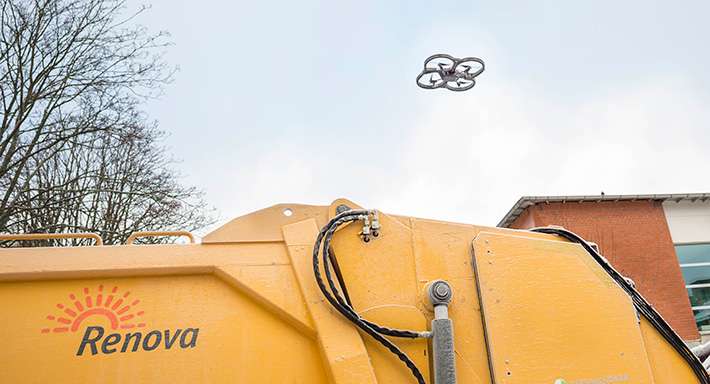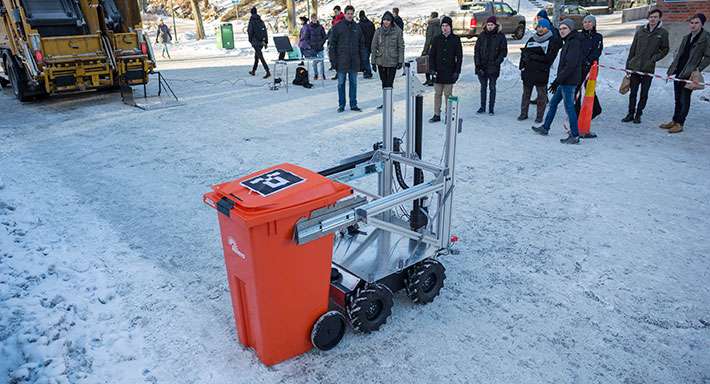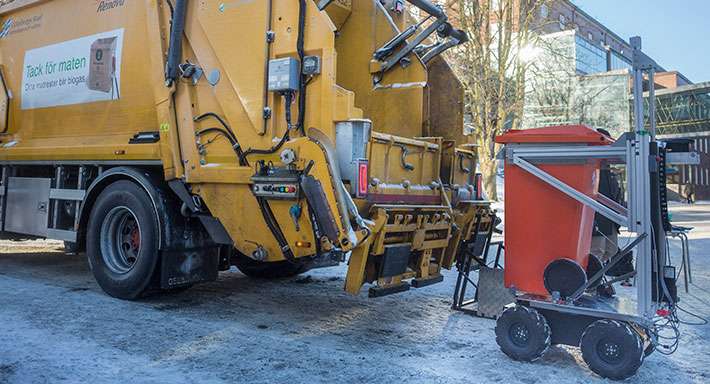Refuse-collecting robot successfully tested

Students from three universities have collaborated with the Volvo Group and the waste recycling company, Renova. The result is a robot that automatically collects and empties refuse bins. A drone on the roof of the refuse truck scans the area and helps the robot to find the bins.
Through the student project ROAR, Robot-based Autonomous Refuse handling, we demonstrate how smart machines will soon be able to communicate with each other to facilitate everyday life in a large number of areas – not just refuse handling.
The ROAR project is a collaboration between the Volvo Group, Chalmers University of Technology, Mälardalen University, Penn State University in the United States, and Renova.
In technical terms, a prerequisite for the robot's work is that it already knows the neighborhood in the form of a map of both the maneuverable area and likely bin locations. The robot then uses a number of different sensors to keep itself positioned within this map, enabling it to automatically perform its tasks. The sensors include GPS, LiDAR (a system similar to radar but using infrared light instead of radio waves), cameras, and IMU data, which uses accelerometers and gyroscope for navigation as well as odometry where motion sensors measure the position changes over time.
It took the students and researchers from the three participating universities only four months to design and build the prototype robot that automatically collects and empties the refuse bins. Mälardalen University was responsible for designing the robot itself and Penn State University developed the web based 3D interface that allows the driver to monitor the situation and, if need be, control the robot.

At Chalmers University of Technology, three student groups were involved in developing systems for bin detection, safe emptying, and overall system coordination.
One group worked on the autonomous drone system to detect bins within the area and return their positions, for the later pickup by the robot. Another group worked with safe automatic bin emptying, thus connected the lift on the refuse truck to a camera system with a human detection algorithm in order to pause the emptying if someone came to close. The third group worked with the overall coordination of the different sub-systems. In close collaboration with the other project groups, they derived a model to describe the operation of the system as well as how to handle error situations.
"The project has been appreciated by the students since they have been given the possibility to develop their own system whilst communicating and integrating with people with other technical backgrounds working on other parts of the system", says Petter Falkman Head of the Educational Programme in Automation and Mechatronics at Chalmers.

When it is time to begin waste collection, the driver of the refuse truck presses a button. This starts the robot and the drone simultaneously lifts from the roof of the truck. Flying through alleyways, the drone quickly finds the location of the refuse bins and communicates their positions to the robot. This is followed by automatic waste collection and emptying by the robot. In the cab, the driver is able to monitor the exact location of the robot and the emptying process.

















